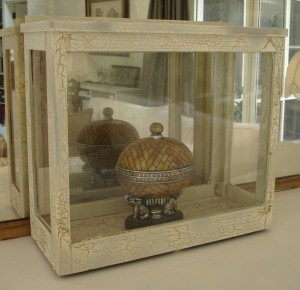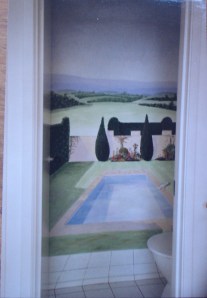Wow – this room had some issues. Firstly, it wasn’t a regular shape: the far wall was angled so that one side wall was longer than the other, destroying symmetry and giving a slightly weird feel to the room. Then, to compound this, there was no focal point: no fireplace, no view, nothing on which to centre the room. The ceilings were not soaring – at 2.4m they were the minimum legal height in Australia, and the fact that the windows stopped well short of the ceiling meant that the room felt squashed downwards. The floor was cheap timber veneer, and a strange zig-zag brick wall separated the stairs.
This was a huge project.

Rather than replace the floor, which would be costly, and wasteful of resources, the decision was made to paint it. Painted floors have been around for centuries in Europe and can add a fabulous dimension to a room. Using gloss white paint means that light is reflected back up, reducing the slightly oppressive feel of the ceiling, and creating a vibrant quality of light that really lifts the whole room.
Then a major decision was made to address the partial wall dividing the stairs. This stopped light coming down, and although it doesn’t look so bad in this photo, actually was a rather ugly lump of brick.

The wall was partially demolished first. Rather than remove it completely, partial removal would allow the existing stairs to be made wider, and thereby more graceful.

Here you can see that the stairs had also been made using the timber veneer and that rather unattractive metal plates had been put on their edges. Fine for commercial application, but a little heavy-handed for domestic.

The stairs were replaced with recycled wood from a bridge girder, complete with all the wear, tear and bolt holes.

Here you can start to see the effects of just replacing the stairs and painting the floor. The lack of architectural features, also meant that while the floor was being painted, we replaced the 3mm wood around the edge with proper skirting boards.

The question of the focal point was addressed with a false fireplace. Putting in a gas fire was considered, but as this home already has ducted heating, it wasn’t considered a worthwhile spend. An old mantlepiece was recycled – this represented a considerable cost saving as new ones cost $1500 to $2000, and this was picked up for $200. It required stripping and repainting, but all round, a better solution.
The mantle was built in to conceal the stereo and CD collection, so it also performs a function. The inside was painted darker so that it was more convincing as a fireplace.

The mantlepiece was painted to match the floor. The mirror on top creates the illusion of height by extending the full distance to the ceiling. This is an old mirror that has been recycled – it’s silvering is beautifully antiqued so that is reflects a softer version of the room.
The poorly shaped windows and low ceiling were further disguised by blinds that cover the gap between the top of the window and the ceiling, giving the impression that the windows continue beyond the blinds. Vertical lines and the impression of height were created with elegant, generous curtains. These were made from end-of-line fabric remnants from top designers which meant that a lower cost was paid for exquisite fabric.

Some ‘new’ furnishings were selected – from reclaimed sources… A linen and wood trunk forms a coffee table and good storage beside the sofa. Two vintage lamps frame the ends of the lounge and provide task lighting for reading.

Strong symmetry was created around the focal fireplace to counteract the angled back wall: a pair of large pictures frame it either side. Furniture was set in a U-shape so that conversation is comfortable. The television was offset, so that it can be seen, but doesn’t dominate the room.
Every view of the room was designed to look appealing and welcoming. Walking in from the corridor, you are greeted by an glimpse of a space with personality that invites further exploration. The positioning of a tiny vintage leather suitcase breaks up what might have been too much white.

Every seat has access to a table, but also to books or items of interest. This room is designed so that you want to spend time there.

An old foot stool was covered in luxurious silk and used as a side table, piled with inviting books. An old pine chest was repurposed as another table, the various elements linked through a uniting colour scheme and intricate, geometric surface designs.
The most expensive part of this makeover was the stairs. Otherwise, costs were minimal. Recycled material were used almost exclusively, and some things were saved (like the floor) rather than being thrown out and replaced.
2 Responses »



























